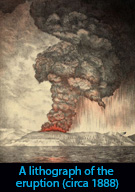Sometimes the World Opens to Inspection
Dr. John Bartlit
New Mexico Citizens
for Clean Air & Water
Column of January 3, 2016, Los Alamos Monitor
 On rare occasions, the world opens itself to being inspected in new and unusual ways. Such a time came in 1883 on a scale that was unthinkable.
On rare occasions, the world opens itself to being inspected in new and unusual ways. Such a time came in 1883 on a scale that was unthinkable. Some story lines of the past grow larger in hindsight. In 1883, Karl Marx died; Bernard Kroger opened his first grocery store; and Charles Fritts used selenium and gold to make the first working, solid-state solar cell. Their aftereffects are with us today.
The larger news was in August that year: A volcanic island exploded in the Sunda Strait between the islands of Java and Sumatra. The blast went round the world and turned the island with the oddly harsh name – “Krakatoa” – into a treasure trove for science.
Effects of the rarity advanced the ways in which we know the world. The stories fill a global canvas.
Evidence says the blast was the loudest sound on Earth in recorded history. The British ship Norman Castle was 40 miles from Krakatoa at the time of the explosion. The ship’s captain wrote in his log, “So violent are the explosions that the ear-drums of over half my crew have been shattered.”
At 1,300 miles distance, reports read “extraordinary sounds were heard, as of guns firing.” The sound was clearly heard 3,000 miles away in the Indian Ocean, reported as “coming from the eastward, like the distant roar of heavy guns.”
At that distance, the sound had traveled for four hours from its source. That muffled roar was the most distant sound ever heard on Earth.
Beyond 3,000 miles, the pressure pulses grew too weak for human ears to detect as sound. Still, the pressure waves pushed on, circling the globe in both directions for some five days.
On each tour around the world, the pressure pulses caused spikes on barographs used to record atmospheric pressure at the world’s weather stations. All told, the pulses were recorded passing around the world three to four times.
The most deadly effects were tsunamis, the ominous waves that cross oceans. The largest of these rose over 100 feet high and destroyed 165 towns and villages in its way. Rumor-sized tsunamis were the chief killer of people, estimated from 36,000 to 120,000. Tidal surges then traveled the Earth for a day, as recorded on tide gauges around the world.
In terms of energy released, the effects wrought by Krakatoa work out to be 10,000 times more energy than in the atomic blast at Hiroshima.
The exploding island hurled dust and acid gases to a height of 50 miles. The world learned that debris at this altitude spreads surprising effects surprisingly far for a surprisingly long time.
Spectacular sunsets were seen around the world for nearly three years. The Earth’s average temperature for the first year dropped by more than a degree.
The peculiar weather patterns led to the discovery of the jet stream, which at first was called the “equatorial smoke stream.”
More wonders: When biologists first visited the island eight months after the eruptions, the only living thing they found was a spider in a crevice. Researchers five months later found grass shoots already growing. Life forms are stubborn.
As with many good stories, ours ends with the oddest stroke of nature—people. The setting was in the Dutch East Indies when Krakatoa blew itself apart and two-thirds of it disappeared beneath the sea. Now, of course, this is Indonesia, the nation with the world’s largest Muslim population.
A noted journalist and author has written that the willingness of Javanese to blame the gods for the destruction of their islands and villages opened the door to Islamic militants. Still others contend the great blast of ‘83 barely mattered in the inexorable stream of history that turns political tides.
Indeed, never doubt that people’s myths, science and politics supply the crosscurrents latent in history.